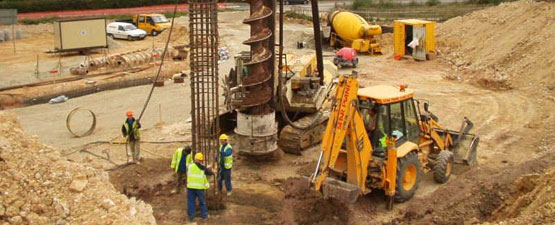Comprehensive Geotechnical Works to Guarantee Site Stability
Comprehensive Geotechnical Works to Guarantee Site Stability
Blog Article
Just How Consulting Engineers Enhance Geotechnical Engineering Projects: Insights Into Their Competence, Approaches, and Collaborative Approaches
Consulting engineers are pivotal in enhancing geotechnical design jobs, applying their specialized expertise to browse the intricacies of subsurface problems. Their methods encompass an array of website investigation techniques, consisting of Requirement Penetration Examinations (SPT) and Cone Penetration Examinations (CPT), which educate vital decisions throughout the style and construction stages. Additionally, their collaborative techniques foster communication amongst diverse task stakeholders, eventually shaping the job's trajectory. As we check out the diverse duties these experts play, it becomes clear that their contributions expand beyond technological knowledge, motivating a better consider the ramifications for task success.
Duty of Consulting Engineers
The proficiency of consulting designers in geotechnical engineering is essential to the successful execution of building and construction projects. These specialists play an essential duty in evaluating soil and rock residential or commercial properties, which are vital variables influencing design and building choices. By performing comprehensive site examinations, getting in touch with designers collect important data that notifies the style process, making sure tasks are developed on steady and appropriate ground.
Consulting designers likewise supply very useful understandings right into threat monitoring (geotechnical geologist). They recognize possible geotechnical threats, such as landslides, dirt liquefaction, and negotiation concerns, making it possible for stakeholders to apply reliable reduction methods. Their experience help in enhancing foundation styles, which can result in significant cost financial savings and boosted security
Moreover, speaking with engineers function as an essential web link in between project owners, engineers, and service providers. Their capability to equate complex geotechnical information into actionable referrals promotes collaboration and facilitates educated decision-making throughout the job lifecycle. This multidisciplinary approach not just improves project performance however also makes certain compliance with regulatory criteria and best techniques.
Secret Methodologies in Geotechnical Design

One key method is website investigation, which involves carrying out field tests and laboratory analyses to gather information on subsurface conditions. Strategies such as Criterion Infiltration Screening (SPT) and Cone Infiltration Screening (CPT) are extensively made use of to review soil stratigraphy and stamina. Additionally, geophysical techniques, including seismic and electrical resistivity studies, offer non-invasive means to analyze subsurface qualities.
An additional vital method is mathematical modeling, which allows designers to imitate various circumstances and predict exactly how soil-structure interactions will certainly act under various loading problems. Limited Element Analysis (FEA) is a typical technique used in this context.
Moreover, the style of structures, preserving structures, and earthworks counts greatly on these techniques - geotechnical geologist. By integrating sophisticated analytical devices with area information, seeking advice from engineers can develop customized solutions that resolve certain job challenges, eventually contributing to the stability and safety of construction jobs
Significance of Dirt Analysis
Soil evaluation acts as a fundamental element in geotechnical design, giving crucial understandings right into the physical and chemical residential properties of soil go to this website needed for effective building and construction planning. Recognizing soil features is vital for determining its load-bearing capability, drainage behavior, and capacity for settlement or instability. Detailed dirt examinations, consisting of tasting and lab screening, assistance identify parameters such as soil type, moisture content, thickness, and shear strength.
These analyses educate the choice of proper building and construction methods and materials, ultimately influencing project security and durability. For example, natural dirts might require various foundation styles contrasted to granular soils, demanding customized engineering solutions. Additionally, dirt analysis aids in determining contaminants that can present dangers to human health and wellness or the setting, permitting the advancement of reduction methods.
Incorporating dirt evaluation into the very early phases of task development assists to decrease unanticipated obstacles, ensuring that engineers can anticipate and address possible concerns prior to they intensify. By developing a detailed understanding of the site problems, consulting designers can enhance style performance and reduce costs, thereby boosting the overall success of geotechnical design tasks.
Collective Strategies in Tasks
Effective geotechnical projects frequently depend upon collective techniques that unite varied proficiency from various techniques. Reliable cooperation amongst seeking advice from engineers, geologists, ecological scientists, and construction specialists is essential for addressing intricate challenges and maximizing job outcomes. By leveraging the distinct skills and understanding of each group participant, jobs can benefit from an alternative understanding of the website problems, original site regulative demands, and engineering restraints.
Routine interaction and interdisciplinary meetings facilitate the sharing of insights and foster a culture of team effort. These collaborative initiatives allow the identification of potential risks early in the project lifecycle, permitting prompt Bonuses mitigation techniques. Integrating comments from stakeholders, consisting of local neighborhoods and regulative firms, ensures that all perspectives are thought about, improving task approval and compliance.
Additionally, the combination of sophisticated innovations, such as Geographic Details Equipment (GIS) and Building Information Modeling (BIM), further improves partnership. These devices enable for the real-time sharing of data and visualization of geotechnical problems, advertising informed decision-making. Inevitably, a collaborative technique not only improves task execution but additionally lays the foundation for innovative solutions to complex geotechnical engineering challenges.
Effect On Task End Results

Consulting designers employ innovative approaches such as threat evaluation and anticipating modeling, which enhance the precision of project projections. Their ability to incorporate innovative innovations, like geotechnical instrumentation and information analytics, even more improves the design and building and construction processes. Because of this, projects experience enhanced performance, decreased expenses, and minimized hold-ups.
Moreover, promoting reliable communication and partnership amongst employee boosts problem-solving abilities. When difficulties emerge, a united front enables for speedy identification of services, protecting against potential problems. Eventually, the joint initiatives of speaking with engineers contribute to greater quality outcomes, making sure that tasks fulfill both regulatory standards and client expectations.
Final Thought

Report this page